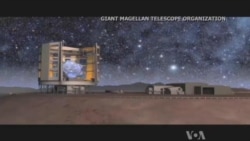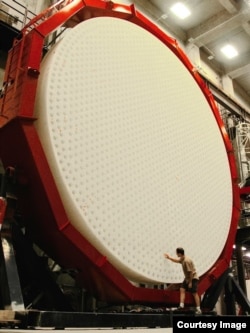A new telescope is being readied to probe the mysteries of the cosmos. Once completed, the Giant Magellan Telescope will be the most powerful on the planet.
The instrument is under construction at the University of Arizona and, when it's completed by 2020, will allow astronomers to probe the origin of the universe.
“We want to know what is the overall size and structure of the universe. What is it comprised of? What is our place in the universe?" said Patrick McCarthy, director of the Giant Magellan Telescope Organization, who came to the American Astronomical Society Annual Meeting in Washington. "Are there other planets in the universe that might hold life? And what is the overall fate and evolution of the universe? So we just want to know, where are we? And who else is with us?”
The 25-meter diameter telescope is comprised of seven mirrors that work together to make a single optical telescope. Each of the mirrors is 8.4 meters in diameter. Even though Magellan is based on Earth, and gathering light that is filtered through the atmosphere, it will offer the highest resolution images ever seen to explore deep space.
Magellan’s enormous light collecting capacity will allow it to follow the path of our evolving universe, from gas and elementary particles to the rich world of galaxies, stars and planets we see today.
“Once you see them, then you can start to actually look at their atmospheres to see if there are signs of life or at least biomarkers like water, oxygen, chlorophyll perhaps," McCarthy said. "And then on the very largest scales, we can measure the expansion history of the universe and try to understand this mysterious acceleration and ask what the fate of the universe is 100 billion years from now.”
Each mirror is the product of cutting-edge technology and processing. First, a mold is built that can accommodate and cast some 20 tons of crushed glass.
“You put the glass in there. You enclose it in a furnace filled with heating filaments," McCarthy said. "You heat it up to about 2,000 degrees. As the glass starts to melt, we spin the furnace. We rotate it so as it melts, the glass takes a natural parabolic shape.”
After two days spinning the mirror is allowed to cool, one degree a day for four months, to avoid stresses that could lead to cracks.
“Then after those four months, we open the top, and see what we have got," McCarthy said. "And we just did that on mirror number three and it is beautiful.”
But there’s much more work to do, to polish the glass smooth to just the right prescription, with finer and finer tools. The $1-billion project is the largest privately led telescope initiative in history, a global partnership among academic and science institutions.
“It is 10 years of problem solving challenges, careful thinking, doing something that you have never done before," McCarthy said. "That is why it takes a big team, very talented people, a lot of thought, a lot of planning.”
The Giant Magellan is slated to begin operation on a Chilean mountain top in 2020, with four of its seven primary mirrors. When the final stages are complete, it will have 10 times the resolution of the Hubble Space Telescope. McCarthy acknowledges that he probably will not be around to reap its benefits.
“These kinds of projects are kind of career-length projects or pretty close to it," he said. "So people like myself, we do this knowing that the next generation will be the users. They will be the ones to make the discoveries. Discoveries that we cannot yet even imagine.”
The instrument is under construction at the University of Arizona and, when it's completed by 2020, will allow astronomers to probe the origin of the universe.
“We want to know what is the overall size and structure of the universe. What is it comprised of? What is our place in the universe?" said Patrick McCarthy, director of the Giant Magellan Telescope Organization, who came to the American Astronomical Society Annual Meeting in Washington. "Are there other planets in the universe that might hold life? And what is the overall fate and evolution of the universe? So we just want to know, where are we? And who else is with us?”
The 25-meter diameter telescope is comprised of seven mirrors that work together to make a single optical telescope. Each of the mirrors is 8.4 meters in diameter. Even though Magellan is based on Earth, and gathering light that is filtered through the atmosphere, it will offer the highest resolution images ever seen to explore deep space.
Magellan’s enormous light collecting capacity will allow it to follow the path of our evolving universe, from gas and elementary particles to the rich world of galaxies, stars and planets we see today.
“Once you see them, then you can start to actually look at their atmospheres to see if there are signs of life or at least biomarkers like water, oxygen, chlorophyll perhaps," McCarthy said. "And then on the very largest scales, we can measure the expansion history of the universe and try to understand this mysterious acceleration and ask what the fate of the universe is 100 billion years from now.”
Each mirror is the product of cutting-edge technology and processing. First, a mold is built that can accommodate and cast some 20 tons of crushed glass.
“You put the glass in there. You enclose it in a furnace filled with heating filaments," McCarthy said. "You heat it up to about 2,000 degrees. As the glass starts to melt, we spin the furnace. We rotate it so as it melts, the glass takes a natural parabolic shape.”
After two days spinning the mirror is allowed to cool, one degree a day for four months, to avoid stresses that could lead to cracks.
“Then after those four months, we open the top, and see what we have got," McCarthy said. "And we just did that on mirror number three and it is beautiful.”
But there’s much more work to do, to polish the glass smooth to just the right prescription, with finer and finer tools. The $1-billion project is the largest privately led telescope initiative in history, a global partnership among academic and science institutions.
“It is 10 years of problem solving challenges, careful thinking, doing something that you have never done before," McCarthy said. "That is why it takes a big team, very talented people, a lot of thought, a lot of planning.”
The Giant Magellan is slated to begin operation on a Chilean mountain top in 2020, with four of its seven primary mirrors. When the final stages are complete, it will have 10 times the resolution of the Hubble Space Telescope. McCarthy acknowledges that he probably will not be around to reap its benefits.
“These kinds of projects are kind of career-length projects or pretty close to it," he said. "So people like myself, we do this knowing that the next generation will be the users. They will be the ones to make the discoveries. Discoveries that we cannot yet even imagine.”













